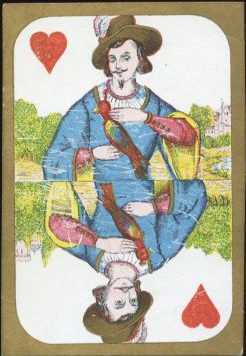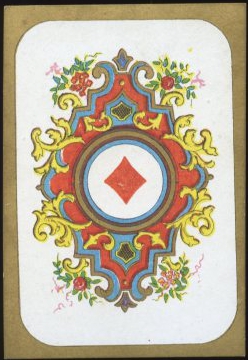August
2022
|
 |
|
|
Since
October last year I've had to part from rare antique, vintage and
nonstandard modern decks. Of most of them I already had scans or they
were presented somewhere on this site. So I can always revisit
them. |
But
sometimes I don't have scans of the complete deck and when it's a
special one I sneak it in. In one of the xpo's or in this spot. This
month a deck which was mentioned in one of the Lockdown series. |
Edouard
Alexis Daveluy was born on May 31, 1812. In 1835 he came to Bruges to start a
lithographic print shop. The Daveluy company became renowned for their so-called
porcelain cards and has produced these cards until his son Viktor took over the
business in 1866. But in February 1847 Daveluy registered a trade mark (déposé)
for a wrapper of a special deck of cards and in October of that year he acquired
a certificate (brevet) to produce playing cards by color print or
chromolithography. So, although an exact date or year isn't known, it's likely
that Daveluy began their playing card production in or not long after 1847. In
2004 the B.E.J.C. published an extensive book about the Daveluy family and their
works. It was written by Alex Claes, Filip Cremers, Jan D'Hondt, Luc Biebouw and
Yvette Smet. In the book 33 different decks are described. Some have only been
published for a short while, but this deck here has seen several editions. I've
shown a few of them as an
extra to the first Lockdown series. This deck here is my earliest and dates
from the 1850's.
|
It's one of the decks
that were printed on porcelain card. Hence the bright white background
within the gold coloured borders. |
|

|
|
 |

|
The
"Moyen Age" deck derives its name from the medieval clothing, that the
unnamed characters on the courts wear.
Above
I've enlarged the middle circle of the AS, because of the spelling mistake. In
French "cartes" is female and the correct adjective should be "brevetées".
 |
 |
 |
 |
| This
was corrected in later editions. |
|

|
|
 |

|
|
Daveluy was the first to
use different sceneries as background on the courts. This concept was soon
copied by makers from Turnhout. |
 |
 |

|
|
|
|
The deck has 52 cards with plain blue backs; it came in the original box. |

|
|

|
BACK
TO PRESENT MONTH


















